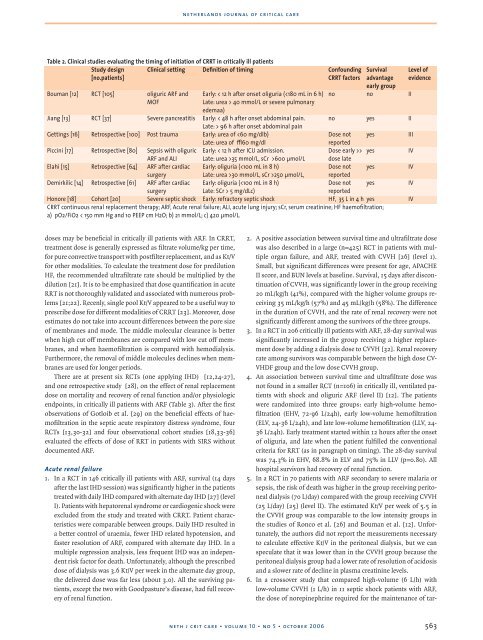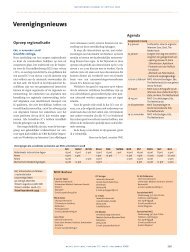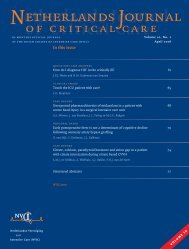Netherlands Journal
NJCC Volume 10, Oktober 2006
NJCC Volume 10, Oktober 2006
- No tags were found...
You also want an ePaper? Increase the reach of your titles
YUMPU automatically turns print PDFs into web optimized ePapers that Google loves.
netherlands journal of critical care<br />
Table 2. Clinical studies evaluating the timing of initiation of CRRT in critically ill patients<br />
Study design<br />
[no.patients]<br />
Clinical setting Definition of timing Confounding<br />
CRRT factors<br />
Bouman [12] RCT [105] oliguric ARF and<br />
MOF<br />
Early: < 12 h after onset oliguria ( 40 mmol/L or severe pulmonary<br />
edemaa)<br />
Survival<br />
advantage<br />
early group<br />
no no II<br />
Jiang [13] RCT [37] Severe pancreatitis Early: < 48 h after onset abdominal pain. no yes II<br />
Late: > 96 h after onset abdominal pain<br />
Gettings [16] Retrospective [100] Post trauma Early: urea of > yes<br />
IV<br />
ARF and ALI<br />
Late: urea >35 mmol/L, sCr >600 µmol/L dose late<br />
Elahi [15] Retrospective [64] ARF after cardiac Early: oliguria (30 mmol/L, sCr >250 µmol/L, reported<br />
Demirkilic [14] Retrospective [61] ARF after cardiac Early: oliguria ( 5 mg/dLc)<br />
reported<br />
Honore [18] Cohort [20] Severe septic shock Early: refractory septic shock HF, 35 L in 4 h yes IV<br />
CRRT continuous renal replacement therapy; ARF, Acute renal failure; ALI, acute lung injury; sCr, serum creatinine; HF haemofiltration;<br />
a) pO2/FiO2 < 150 mm Hg and 10 PEEP cm H2O; b) 21 mmol/L; c) 420 µmol/L.<br />
Level of<br />
evidence<br />
doses may be beneficial in critically ill patients with ARF. In CRRT,<br />
treatment dose is generally expressed as filtrate volume/kg per time,<br />
for pure convective transport with postfilter replacement, and as Kt/V<br />
for other modalities. To calculate the treatment dose for predilution<br />
HF, the recommended ultrafiltrate rate should be multiplied by the<br />
dilution [21]. It is to be emphasized that dose quantification in acute<br />
RRT is not thoroughly validated and associated with numerous problems<br />
[21;22]. Recenly, single pool Kt/V appeared to be a useful way to<br />
prescribe dose for different modalities of CRRT [23]. Moreover, dose<br />
estimates do not take into account differences between the pore size<br />
of membranes and mode. The middle molecular clearance is better<br />
when high cut off membranes are compared with low cut off membranes,<br />
and when haemofiltration is compared with hemodialysis.<br />
Furthermore, the removal of middle molecules declines when membranes<br />
are used for longer periods.<br />
There are at present six RCTs (one applying IHD) [12,24-27],<br />
and one retrospective study [28], on the effect of renal replacement<br />
dose on mortality and recovery of renal function and/or physiologic<br />
endpoints, in critically ill patients with ARF (Table 3). After the first<br />
observations of Gotloib et al. [29] on the beneficial effects of haemofiltration<br />
in the septic acute respiratory distress syndrome, four<br />
RCTs [13,30-32] and four observational cohort studies [18,33-36]<br />
evaluated the effects of dose of RRT in patients with SIRS without<br />
documented ARF.<br />
Acute renal failure<br />
1. In a RCT in 146 critically ill patients with ARF, survival (14 days<br />
after the last IHD session) was significantly higher in the patients<br />
treated with daily IHD compared with alternate day IHD [27] (level<br />
I). Patients with hepatorenal syndrome or cardiogenic shock were<br />
excluded from the study and treated with CRRT. Patient characteristics<br />
were comparable between groups. Daily IHD resulted in<br />
a better control of uraemia, fewer IHD related hypotension, and<br />
faster resolution of ARF, compared with alternate day IHD. In a<br />
multiple regression analysis, less frequent IHD was an independent<br />
risk factor for death. Unfortunately, although the prescribed<br />
dose of dialysis was 3.6 Kt/V per week in the alternate day group,<br />
the delivered dose was far less (about 3.0). All the surviving patients,<br />
except the two with Goodpasture’s disease, had full recovery<br />
of renal function.<br />
2. A positive association between survival time and ultrafiltrate dose<br />
was also described in a large (n=425) RCT in patients with multiple<br />
organ failure, and ARF, treated with CVVH [26] (level 1).<br />
Small, but significant differences were present for age, APACHE<br />
II score, and BUN levels at baseline. Survival, 15 days after discontinuation<br />
of CVVH, was significantly lower in the group receiving<br />
20 mL/kg/h (41%), compared with the higher volume groups receiving<br />
35 mL/kg/h (57%) and 45 mL/kg/h (58%). The difference<br />
in the duration of CVVH, and the rate of renal recovery were not<br />
significantly different among the survivors of the three groups.<br />
3. In a RCT in 206 critically ill patients with ARF, 28-day survival was<br />
significantly increased in the group receiving a higher replacement<br />
dose by adding a dialysis dose to CVVH [32]. Renal recovery<br />
rate among survivors was comparable between the high dose CV-<br />
VHDF group and the low dose CVVH group.<br />
4. An association between survival time and ultrafiltrate dose was<br />
not found in a smaller RCT (n=106) in critically ill, ventilated patients<br />
with shock and oliguric ARF (level II) [12]. The patients<br />
were randomized into three groups: early high-volume hemofiltration<br />
(EHV, 72-96 L/24h), early low-volume hemofiltration<br />
(ELV, 24-36 L/24h), and late low-volume hemofiltration (LLV, 24-<br />
36 L/24h). Early treatment started within 12 hours after the onset<br />
of oliguria, and late when the patient fulfilled the conventional<br />
criteria for RRT (as in paragraph on timing). The 28-day survival<br />
was 74.3% in EHV, 68.8% in ELV and 75% in LLV (p=0.80). All<br />
hospital survivors had recovery of renal function.<br />
5. In a RCT in 70 patients with ARF secondary to severe malaria or<br />
sepsis, the risk of death was higher in the group receiving peritoneal<br />
dialysis (70 L/day) compared with the group receiving CVVH<br />
(25 L/day) [25] (level II). The estimated Kt/V per week of 5.5 in<br />
the CVVH group was comparable to the low intensity groups in<br />
the studies of Ronco et al. [26] and Bouman et al. [12]. Unfortunately,<br />
the authors did not report the measurements necessary<br />
to calculate effective Kt/V in the peritoneal dialysis, but we can<br />
speculate that it was lower than in the CVVH group because the<br />
peritoneal dialysis group had a lower rate of resolution of acidosis<br />
and a slower rate of decline in plasma creatinine levels.<br />
6. In a crossover study that compared high-volume (6 L/h) with<br />
low-volume CVVH (1 L/h) in 11 septic shock patients with ARF,<br />
the dose of norepinephrine required for the maintenance of tar-<br />
neth j crit care • volume 10 • no 5 • october 2006<br />
563







